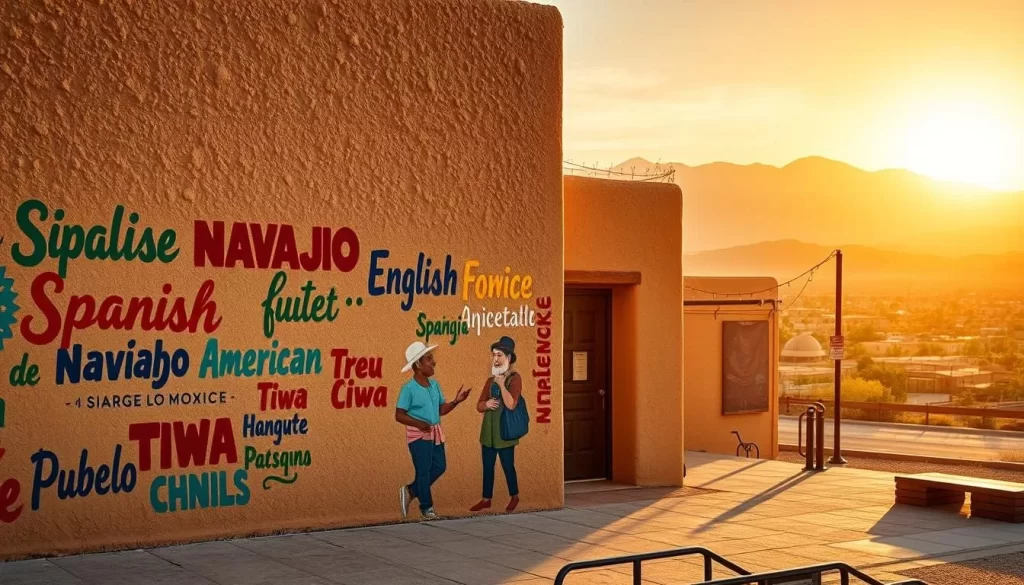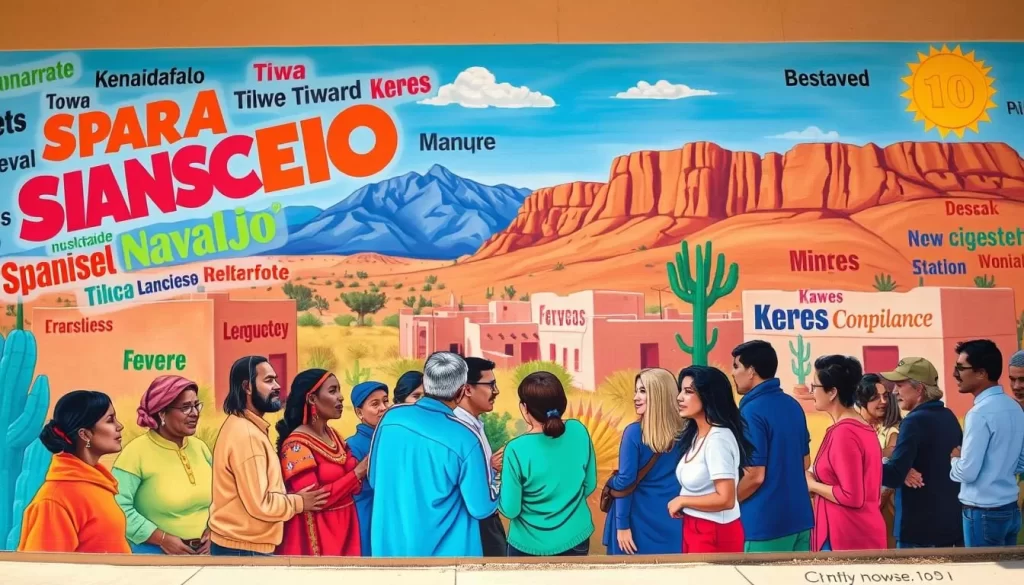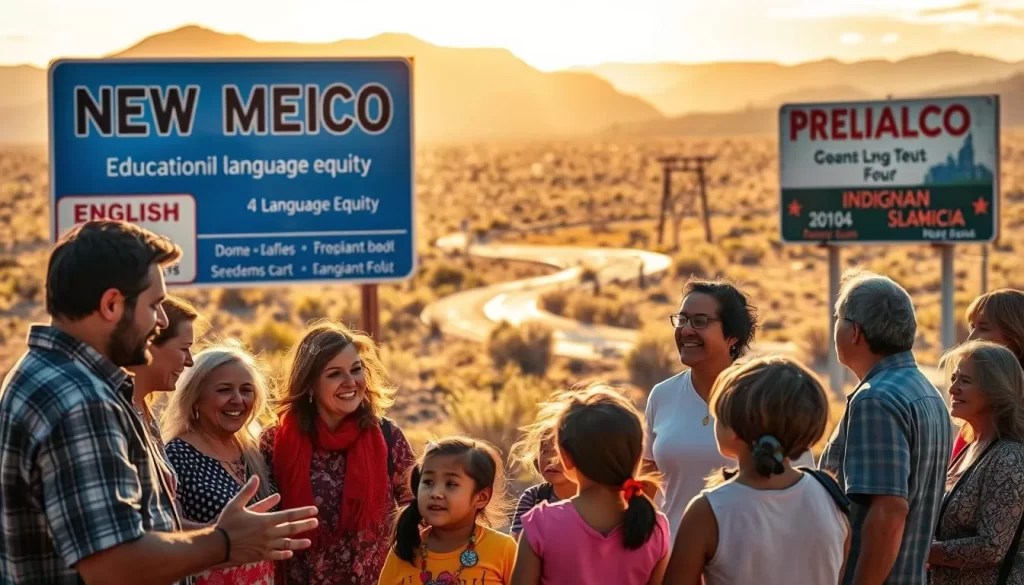✓ Accommodations✓ Flights✓ Rental Cars
You’ll find that New Mexico is a melting pot of languages, reflecting its rich cultural heritage. With a population of approximately 2.11 million people, the state boasts a unique linguistic landscape.
While English is the predominant language, about 33% of residents over the age of 4 speak a non-English language at home, totaling around 697,403 people. This diversity is a result of the state’s history, from indigenous Native American languages to Spanish colonial influence and modern immigration patterns.
As you explore the linguistic diversity of New Mexico, you’ll gain insights into the state’s cultural heritage and how language shapes the community. The state’s bilingual heritage is reflected in government, education, and daily life.
The Linguistic Landscape of New Mexico
As a cultural crossroads, New Mexico boasts a diverse linguistic landscape. With approximately 2.11 million people calling New Mexico home, the state’s language demographics are noteworthy. While most residents speak English, about 33% of New Mexicans above the age of 4 (an estimated 697,403 people) speak a non-English language at home.
This diversity is a result of the state’s unique position, where Native American, Spanish, and other influences have shaped the linguistic landscape.

Cultural and Linguistic Diversity
New Mexico’s cultural heritage is reflected in its linguistic diversity. The state’s history as a crossroads has created a rich tapestry of languages. You’ll discover how this diversity has shaped the state’s identity.
- The state’s unique position has led to a blend of languages.
- Native American languages are prevalent in certain regions.
- Spanish is widely spoken, particularly along the southern border.
Language Demographics Overview
The language demographics in New Mexico reveal that about 9.55% (approximately 201,824 people) have limited English proficiency (LEP).
This data highlights the importance of language diversity in the state, with implications for education, healthcare, and other services.
Immigration History and Its Impact on Languages
As you explore New Mexico, you’ll discover how its unique immigration patterns have impacted the languages spoken there. The state’s history is a complex tapestry woven from the threads of various cultures.
Native American Presence
Initially, New Mexico was home only to Native Americans, who, despite colonization, maintained their languages. Today, they represent about one-tenth of the state’s population.
Spanish and Hispanic Influence
The arrival of settlers, mostly of Mexican, Latin American, or Spanish origin, established Spanish as a dominant language that has persisted for over 400 years.
Post-World War II Immigration Patterns
After World War II, English-speaking populations of European descent arrived, followed by immigrants from Asia, non-English-speaking Europe, Africa, and the Americas, diversifying the linguistic landscape.
| Immigration Period | Primary Groups | Language Impact |
|---|---|---|
| Pre-Colonization | Native Americans | Indigenous languages |
| Spanish Colonial | Spanish, Hispanic | Spanish dominance |
| Post-WWII | English-speaking Europeans, others | Increased linguistic diversity |

New Mexico, United States: Official and Widely Spoken Languages
Understanding the languages spoken in New Mexico provides insight into the state’s diverse cultural background. As you explore the linguistic landscape, you’ll discover the significance of multiple languages in the state.
English as the Primary Language
English is the primary language used in government, business, and education in New Mexico. Most residents speak English, but a significant portion of the population speaks a non-English language at home.
Bilingual State Status
New Mexico operates as a de facto bilingual state, with Spanish maintaining strong cultural and practical significance alongside English. About 33% of New Mexicans above the age of 4 speak a non-English language at home.
- The state’s linguistic diversity reflects its cultural heritage.
- Language policies acknowledge the multilingual background of the population.
Language Rights and Policies
The state’s constitution contains provisions that protect language rights, particularly for Spanish-speaking residents. Language access requirements affect public services, voting materials, and educational opportunities.
Top 10 Non-English Languages in New Mexico
You can experience the multicultural heritage of New Mexico through its various spoken languages. The state’s diverse linguistic landscape is a result of its rich history and cultural influences.
Spanish (26.04% of Population)
Spanish is the most widely spoken non-English language in New Mexico, with over 514,071 speakers, making up about 26.04% of the population.
Navajo (3.23% of Population)
The Navajo language has a significant presence, particularly in the northwestern regions like San Juan County, with approximately 63,783 speakers, or 3.23% of the population.
Other Native American Languages (1.67% of Population)
Other Native American languages, including Pueblo languages, Apache, and Zuni, are spoken by 32,954 individuals, representing about 1.67% of the population.
European Languages (German, French)
European languages such as German and French are also spoken in New Mexico. German is spoken by about 6,123 residents (0.31%), while French is spoken by approximately 4,040 residents (0.21%).
Asian Languages (Chinese, Tagalog, Vietnamese, Korean)
Asian languages are becoming increasingly prevalent, with 5,201 Chinese speakers, 5,135 Tagalog speakers, 4,460 Vietnamese speakers, and 1,940 Korean speakers.
Arabic and Other Languages
Arabic is spoken by an estimated 2,946 individuals, making up nearly 0.15% of the population. Korean rounds out the top 10 non-English languages spoken in New Mexico.

| Language | Speakers | % of Population |
|---|---|---|
| Spanish | 514,071 | 26.04% |
| Navajo | 63,783 | 3.23% |
| Other Native American | 32,954 | 1.67% |
| German | 6,123 | 0.31% |
| Chinese | 5,201 | 0.26% |
| Tagalog | 5,135 | 0.26% |
| Vietnamese | 4,460 | 0.23% |
| French | 4,040 | 0.21% |
| Arabic | 2,946 | 0.15% |
| Korean | 1,940 | 0.10% |
English Proficiency Among Non-English Speakers
As you explore the linguistic landscape of New Mexico, you’ll discover that English proficiency varies significantly among non-English speakers. The data indicates that about 9.55% of the population, or approximately 201,824 people, have limited English proficiency (LEP).
Limited English Proficiency Statistics
The LEP statistic is a crucial indicator of the challenges faced by New Mexico’s diverse population. Approximately 201,824 residents struggle with English proficiency, which can impact their access to services and economic opportunities.
Variations Across Language Groups
Different language groups in New Mexico exhibit varying levels of English proficiency. For instance, 31.3% of Spanish speakers report speaking English less than “very well,” whereas 14.6% of Navajo speakers and 14.8% of other Native American language speakers have limited English proficiency. Asian language speakers generally show higher rates of LEP, with 42% of Chinese speakers, 59.5% of Vietnamese speakers, and 26.9% of Tagalog speakers reporting they speak English less than “very well.”

You’ll find that these variations in English proficiency have significant implications for the state’s residents. The data highlights the need for targeted programs and resources to improve English language skills, particularly for recent immigrant communities and those in areas like San Juan County.
- The approximately 201,824 New Mexico residents with LEP face challenges in accessing services and economic opportunities.
- English proficiency rates vary significantly across different language groups, with Asian language speakers generally showing higher rates of LEP.
- Programs and resources are available to improve English language skills for residents throughout New Mexico.
Conclusion
The linguistic tapestry of New Mexico is a testament to its multicultural identity. You’ve learned that the state’s language diversity reflects its complex history of indigenous cultures, Spanish colonization, and immigration. With Native American languages and Spanish playing significant roles, New Mexico embraces its multilingual character, offering valuable insights for other multicultural regions in the United States.
The above is subject to change.
Check back often to TRAVEL.COM for the latest travel tips and deals.






